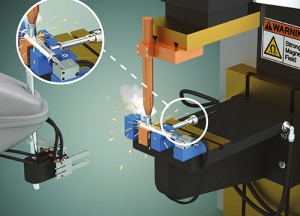Automating the welding of aluminium assemblies
 When a manufacturer of valves wanted to automate the welding of aluminium parts with robots to prevent misalignment, it turned to Contrinex for an inductive proximity sensor that would ensure the presence and position of an aluminium tube, and be able to withstand the electromagnetic interference created by the high currents used in the spot welding process.
When a manufacturer of valves wanted to automate the welding of aluminium parts with robots to prevent misalignment, it turned to Contrinex for an inductive proximity sensor that would ensure the presence and position of an aluminium tube, and be able to withstand the electromagnetic interference created by the high currents used in the spot welding process.
Resistance spot-welding is utilised across many industries, including automotive, aerospace, electronics and white goods, because of its speed and low cost. The high volumes and high-quality requirements of the automotive supply chain tend to make its use of automated welding more common than in other industries.
Contrinex’s 600 Series Weld-Immune inductive sensors bring weld immunity to a new lower price point. Whilst they do not provide the robustness that the 700 Series sensors are renowned for, they do provide a highly reliable, cost-effective solution, with best-in-class service life.
Another important aspect of the 600 and 700 Series weld-immune sensors is that their sensing performance of steel and aluminium targets is the same. This is commonly referred to as being ‘Factor 1’, because their performance on steel is scaled by a Factor of 1.0 for aluminium, whereas some sensors might only provide 85% of the sensing range on aluminium that it provides on steel, and would be described as having a ‘correction factor’ of 0.85.
The sensor has to reliably detect the presence of the aluminium tube and withstand the harsh environment of being located near 50Hz AC-welding equipment, where field strengths may reach 40mT. The lower electrical resistance of aluminium requires welding currents two to three times higher than for steel, so medium-frequency (MF) resistance welding can use currents as high as 15 kA, requiring an inductive sensor with exceptional high-strength weld-field interference immunity.
The valve manufacturer’s welding cell was designed with a high-speed robot gripper loading an aluminium tube and valve body into an assembly jig, where a small pneumatic cylinder positions it longitudinally. A small inductive sensor is located beside the lower welding electrode to confirm the body is correctly positioned before it initiates the welding sequence.
Contrinex’s Weld-Immune inductive sensors have long been trusted to not malfunction or fail, even when directly exposed to strong electromagnetic fields. The new 600 Series weld-immune inductive sensor was a perfect fit for the application, offering weld-immunity, long-sensing range and Factor 1 sensing on steel and aluminium, to give a cost-effective solution, with best-in-class service life.
The M8-diameter sensor’s rugged construction includes a metal housing and a temperature-resistant sensing face in a high-strength PEEK polymer. Its sensing range of up to 2 mm is more than adequate for the process, reducing the chance of accidental impacts during assembly.
Contrinex’s 600 Series of weld-immune inductive sensors offer Factor 1 sensing of steel and aluminium targets up to 8mm in an M18 sensor. The 700 Series offers sensing up to 10 mm from an M18, or 16mm from an M30 sensor. All PNP versions include the IO-Link communication protocol so that parameters can be auto-updated from the PLC to a new sensor when it is installed. IO-Link is also ideal for implementing the sensors into Industrial IoT (IIoT) and Industry 4.0 systems.
Contrinex also offers its robust 700 Series of weld-immune inductive sensors for even more challenging environments. They feature a front face and cylindrical housing which is machined from a single piece of stainless steel, providing a thick front face and extraordinary abrasion resistance. The sensor’s technology gives it unmatched abilities to resist shock and impact damage, which is typically demonstrated by showing a sensor survive being used to hammer nails into a wooden block.
For applications directly exposed to weld spatter, sensors are available with an ACTIVSTONE coating, a high-performance ceramic layer that is especially resistant to weld spatter. All external surfaces of the sensor, including fixing nuts and mounting brackets, are protected, preventing the accumulation of spatter. Heavy-duty PUR cables and optional high-temperature-rated spatter-resistant cable shrouds are also available to provide robust sensor systems.
Combining exceptional durability in harsh environments with extended working life, Contrinex’s Weld-Immune sensor range is a highly affordable, risk-free option for systems integrators and equipment designers in diverse industries, including automotive, aerospace, electronics and white goods.
Contrinex weld immune sensors are available in the UK from Plus Automation.
See all stories for Plus Automation















